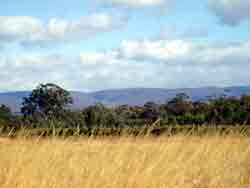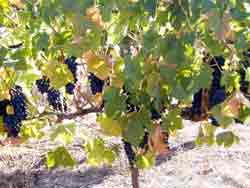


Lamplough Estate is in the Pyrenees region of Central Victoria, on the Sunraysia Highway, seven kilometres south of the town of Avoca.
Shiraz is the signature grape of the region. Locally produced Shirazes are celebrated for their complexity, fullness and richness of texture. However, the Pyrenees is also home to a range of both red and white varietals, including Cabernet, Merlot, Chardonnay, Sauvignon Blanc and premium sparkling wines.
The Pyrenees wine region, which stretches from just outside Waubra on the Sunraysia Highway in the south through St Arnaud, takes its name from the picturesque hills that form a southern extension to the Great Dividing Range outside of Avoca. These hills were named "The Pyrenees" by explorer and Surveyor General of NSW, Major Thomas Mitchell, in 1836, on the cusp of European settlement.
Until the discovery of gold in the Pyrenees Ranges in 1849, the region was sought as grazing land by squatters from as far as Sydney and Tasmania. The Victorian Goldrush of the 1850s gave rapid birth and prosperity to the town of Avoca, named by Mitchell after the Vale of Avoca in County Wicklow, Ireland. Avoca thrives today as the heart of the Pyrenees winegrowing region.
Lamplough sprang up almost overnight following the discovery of gold in 1859. Within a week 3000 hopeful diggers descended upon the area, and by mid-1860 Lamplough was a thriving township of about 16,000 inhabitants, boasting numerous hotels, billiard rooms, schools and churches. The town disappeared just as quickly when the gold ran out, and the rush moved to Moonambel in late 1860. Today little is left of the town, as is the case with so many of the gold rush settlements.
While the Pyrenees first vineyard was planted in the late 1880s, the economic depressions of the 1890s and 1930s, together with the two world wars, brought wine production in the Pyrenees region to a grinding halt. It wasn't until the 1960s that viticulture and wine making resumed in the area.
Yet the suitability of the Pyrenees for the cultivation of vineyards was noted as early as 1864, when the Avoca Mail prophesised that viticulture had the potential of becoming an industry almost indigenous to the district.
In 1886, the Australian Wine Association heard from a Mr Bladier "that the ground which has produced the gold will produce the best wine …indeed, to the recent time the auriferous districts have proved the most favourable for the production of good wines..."
And in 1889, Italian born and trained Romeo Bragato, appointed by the government as viticultural expert, visited the area and concluded that Avoca was better suited to the cultivation of vines than most districts in the colony.
A combination of natural climatic, geographic and geologic conditions make the Pyrenees ideal for producing wine, and since the 1960s the region has experienced a viticultural renaissance. Today, there are over twenty vineyards producing wine under their own label, and the Pyrenees district is recognised by the Australian and international markets as one of the premium wine producing regions of Australia.

